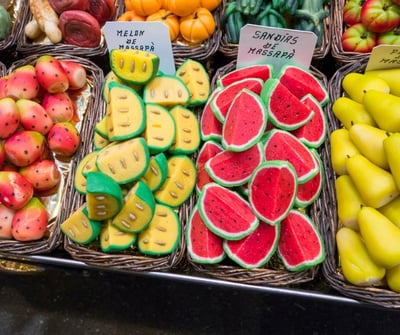Sicilian Marzipan: A Delicious Work of Art
/ in Tour of Sicily, visit sicily, food and wine tours of Sicily, Best of sicily tour, sicilian food / by smadar PalaceMarzipan, that colorful, realistic-looking edible art that’s quite popular in ethnic pockets throughout the US, is a delicious almond confection that shows up around the holiday season. Though most recognized as an Italian, and moreover, Sicilian tradition, the supposed origins of marzipan read like a map of Europe and the Middle East.
What is Marzipan in Sicily?
Marzipan is actually a shortened version of the Sicilian moniker, Frutta di Martorana, which is the traditional Sicilian version. These delightful little gems are almost too beautiful to eat as they are miniature and exquisitely realistic-looking representations of fruit such as apples, peaches, pears, banana and cherries, watermelon strawberries and even corn, tomatoes and peppers.
These little treats are crafted by marzipan artisans from an almond paste called pasta (paste) reale. To make the paste the almonds are finely ground then mixed with sugar, lemon juice. The result is a pliable, easy-to-mold dough from which different shapes can be crafted. Once the marzipan is shaped as desired the confection is ready to be painted with food grade coloring. The result is truly remarkable.
Where Did Marzipan Originate
Though today the marzipan treats are most typically associated with Sicily the origins of the almond paste treat are somewhat unclear. It’s assumed that marzipan came to Sicily from Spain, another country known for its almond production.
It’s widely accepted that the Spaniards were introduced to marzipan by visitors from Arab countries during the early part of the Middle Ages. That idea rings most true as sugar is a necessary ingredient in marzipan (for both flavor and texture), and the Arabs were the ones who introduced sugar cane to both Spain and Sicily. Almond paste was almost certainly first made in Persia, now Turkey.
One bit of trivia? The invention of marzipan is also attributed to the town of Lubeck, Germany. Legend has it that in the 15th century, as famine took out the wheat crops, the officials of the town ordered the bakers to find a suitable replacement and they came up with marzipan. Although other cities such as Konigsburg, Venice and Florence have similar stories about how they invented marzipan out of nutritional necessity.
Suffice it to say, whoever invented this tasty and fun vehicle for artistic expression should be celebrated. We can do so by indulging in these lovely treats ourselves.
The History of Sicilian Marzipan
The tale of traditional Sicilian marzipan begins in Palermo. In the 18th century a convent of monastic nuns, the Convent of the Martorana, were among those nuns who made and sold pastries and confections. This was a popular endeavor of religious orders at that time throughout southern Europe.
The birth of the colorful confection occurred when an Archbishop was scheduled to visit the convent for Easter and the prankster nuns decided to decorate their empty trees with the colorful fruit they made from marzipan.
The Archbishop was duly impressed with the artistry of the “fruit” that he encouraged the nuns to continue in their pursuit and sell the marzipan creations.And voila! Frutta di Martorana was born and an Easter “miracle” had taken place! Such a simple and fun story we choose to believe happened just that way, even though many argue it’s a bit of an urban legend.
The Tradition of Sicilian Marzipan
Today Sicilian marzipan is a tradition that’s spread far and wide. The Sicilian tradition of Frutta di Martorana is a strong one. On the Feast of All Souls, celebrated on November 2nd, children in Sicily wake up to find baskets of marzipan fruit. The children are told the fruit has been left by their long-ago ancestors. There are also festivals on that holiday which include marzipan, or martorana as it is commonly called in Sicily. The marzipan fruits are commonplace at these festivities but the martorana artisans also include statues celebrating everything from saints and historical figures to pop-culture characters.
You can find marzipan creations in some form throughout Sicily and other parts of Italy usually from All Souls’ Day through Easter. Although some of todays’ martorana are made using molds, much of it is still crafted by hand. The painting is always done manually.
Making these beautiful creations is quite labor-intensive and typically takes three days. The first day is spent making the marzipan to the necessary consistency. Next comes the shaping, molding and sculpting of the fruit and painstakingly painting the creation with a mix of food coloring and vodka. Then the almond paste fruits are left to dry. On the final day the martorana marzipan is glazed and after the edible glaze dries the martorana are ready to enjoy or store in an airtight container for up to three months.
Try This Delightful Treat for Yourself
If you aren’t familiar with marzipan the taste is simply amazing, rich with almonds and sweet, but not too sweet. The texture of marzipan is soft and creamy but crumbly at the same time. You definitely realize the presence of the ground almonds, but delightfully so.
You can find marzipan just about anywhere if you look. But to truly enjoy this gorgeous and tasty confection you must sample Frutta di Martorana in the place of its birth-Sicily.
Share this article
-
Share on Facebook
Share on Facebook
-
Share on Twitter
Share on Twitter
-
Share on WhatsApp
Share on WhatsApp
-
Share on Pinterest
Share on Pinterest
-
Share on LinkedIn
Share on LinkedIn
-
Share on Tumblr
Share on Tumblr
-
Share on Vk
Share on Vk
-
Share on Reddit
Share on Reddit
-
Share by Mail
Share by Mail



